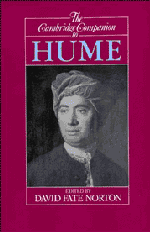Book contents
- Frontmatter
- 1 An introduction to Hume's thought
- 2 Hume's new science of the mind
- 3 Hume and the philosophy of science
- 4 Hume's scepticism
- 5 Hume's moral psychology
- 6 Hume, human nature, and the foundations of morality
- 7 The structure of Hume's political theory
- 8 David Hume: Principles of political economy
- 9 Hume's literary and aesthetic theory
- 10 David Hume, "the historian"
- 11 Hume on religion
- Appendix: Hume's autobiographies
- Bibliography
- Index of Names and Subjects
- Index of Citations and References
9 - Hume's literary and aesthetic theory
Published online by Cambridge University Press: 28 May 2006
- Frontmatter
- 1 An introduction to Hume's thought
- 2 Hume's new science of the mind
- 3 Hume and the philosophy of science
- 4 Hume's scepticism
- 5 Hume's moral psychology
- 6 Hume, human nature, and the foundations of morality
- 7 The structure of Hume's political theory
- 8 David Hume: Principles of political economy
- 9 Hume's literary and aesthetic theory
- 10 David Hume, "the historian"
- 11 Hume on religion
- Appendix: Hume's autobiographies
- Bibliography
- Index of Names and Subjects
- Index of Citations and References
Summary
Hume's observations on art are set in the framework of social life, which is why he considers both the making of, and response to, works of art as human actions subject to the analysis he has offered of other human actions. Although he never published his intended treatise on “criticism” (T Adv [xii]) and no explicit theories of beauty, art, or criticism are to be found in his works, by bringing together his scattered remarks on these subjects, and by looking at his general aims and the context in which he wrote, we can identify his principal views on these topics.
CONTEXT
In establishing Hume's views on what today we call aesthetics, it is important to note their date and their context, and also to recognize that his experiences and references, in almost every respect except the crucial one of classical literature, were narrower than those of an informed modern reader. Concepts of, and attitudes to, the different arts in the 1740s differed from ours, as did artistic practices and expectations,- access to the arts and the availability of them were limited. Hume always claimed to base his tenets on experience, and it is therefore doubly important to understand the intellectual environment in which he wrote. Most of his observations were made within a thirty-year period beginning in the late 1720s, at the outset of the social and intellectual revolutions that were to gain rapid momentum in the second half of the eighteenth century and to transform Europe.
- Type
- Chapter
- Information
- The Cambridge Companion to Hume , pp. 255 - 280Publisher: Cambridge University PressPrint publication year: 1993
- 2
- Cited by



